

Understanding the Core Principles of Successful Software Development






Software development is an iterative, logical process designed to create custom software that meets specific business objectives, personal goals, or organizational needs. While coding is at the heart of the process, the successful development of software involves much more—research, designing data and process flows, writing technical documentation, thorough testing, debugging, and continuous iteration.
Studies show that 70% of software development projects fail due to poorly defined requirements and processes.
Following a structured approach, businesses can avoid common pitfalls and deliver solutions that drive measurable success. This guide outlines the critical phases of the Software Development Life Cycle (SDLC), ensuring your project is built to succeed from the ground up.
With a clear roadmap, the next step is establishing a solid foundation by identifying and understanding the project's core requirements.
The bedrock of successful software product development lies in accurately defining the project's requirements. This involves several crucial steps:
The first step is to deeply understand the core business objectives and the needs of the target audience. Stakeholders must clearly articulate their vision, goals, and long-term strategy to ensure the software aligns with the broader organizational roadmap.
Engaging stakeholders through interviews, surveys, workshops, and focus groups uncovers valuable insights into user pain points, preferences, and expectations. This information enables the development team to design a solution that meets the business requirements and solves real-world problems for the end-users.
Conducting a comprehensive competitive analysis helps teams understand the strengths, weaknesses, and gaps in existing market solutions. By evaluating competitors' user experiences, pricing strategies, feature sets, and overall market positioning, development teams can identify unique selling propositions (USPs) and opportunities for differentiation.
This research also reveals industry trends and user behavior patterns, which can inform better product design and ensure the software offers value that surpasses what’s currently available.
In industries such as healthcare, finance, and data management, compliance is a critical factor. Adhering to regulatory requirements, legal standards, and security protocols is essential to avoid legal penalties, data breaches, and reputational damage.
It must be taken into consideration that regulatory frameworks, such as GDPR, HIPAA, and PCI-DSS, are applicable and incorporated into the planning process so that the designed software meets these obligations from scratch. If this happens to fail, it leads to steep penalties and even more injurious customer trust loss.
After conducting a thorough analysis, the next step is to create a comprehensive Software Requirements Specification (SRS) document. This blueprint outlines the functional and non-functional requirements, system interfaces, user interactions, and data handling procedures.
It also defines clear rules related to the performance, security, and scalability of the system. The SRS acts like a contract between stakeholders and developers in terms of the final product's delivery and ensures that all parties are aligned and transparent about the outcome.
Every software development project comes with technical, operational, or market-related risks. Identifying potential risks early enables teams to create mitigation strategies and contingency plans. Common risks include scope creep, where project requirements grow beyond the original plan, budget overruns, and mismatches in technology choices. By proactively addressing these risks, teams can avoid project delays, unexpected costs, and technological limitations, ensuring smoother project execution.
With a clear understanding of the project's requirements, the next step is to develop a structured plan to guide the team through every development phase.
A well-structured project plan serves as the roadmap for the development process, guiding teams through each project phase.
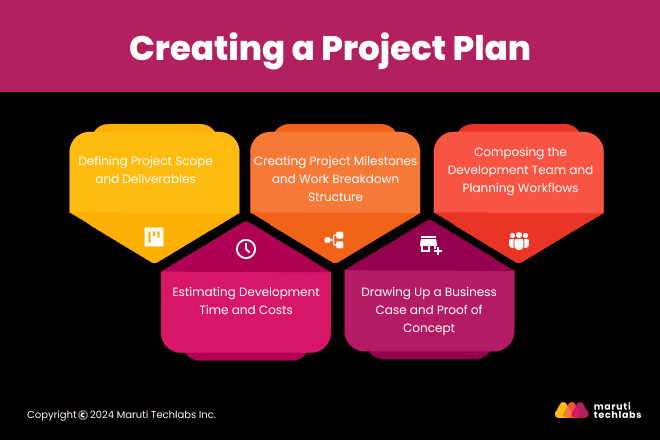
The scope and deliverables of a project are best defined clearly to inhibit misconceptions and scope creep. A clear list of deliverables accompanying the project scope should indicate what outputs the team will have to produce at which stages. This way, the stakeholders share a common vision, and the expectations are right from the onset.
Breaking the project into well-defined milestones and tasks is essential for tracking progress. Milestones represent key achievements in the project timeline, such as completing a prototype, finishing a testing phase, or deploying a feature.
A Work Breakdown Structure (WBS) helps break down the overall project into smaller, manageable tasks, which can be distributed across teams for efficient resource allocation. With milestones and a well-defined WBS, teams can closely track progress, make necessary adjustments, and maintain steady momentum to ensure timely project completion.
The strength of the development team directly reflects the project's success. Building a team requires the correct mix of skills or talent—developers, designers, testers, and project managers. Roles and responsibilities should be allocated to avoid duplication of efforts and confusion.
Working under the Agile methodology or any other iterative framework allows the team to be flexible and responsive to the change in requirements while working toward easy collaboration. The rigorous communication channels, such as stand-ups and sprint reviews, let the team be on the same page and create more productivity.
Accurate estimation of development time and costs is a foundational aspect of project planning. These estimates guide budget allocation, staffing decisions, and timelines. Leveraging historical data from similar projects, along with industry benchmarks, can improve the accuracy of estimates.
Building a contingency buffer is also essential to account for potential challenges or unexpected developments. This keeps the project on course despite challenges, helping to prevent last-minute budget overruns or compressed timelines.
A strong business case demonstrates the project's viability, outlining the expected return on investment (ROI) and justifying the allocation of resources. This document should detail how the software will align with business goals, drive value, and meet market demands.
In addition, developing a Proof of Concept (PoC) provides tangible evidence that the proposed solution is feasible. A successful PoC can help secure stakeholder buy-in by showcasing the potential impact and effectiveness of the software before full-scale development begins.
Once the planning is in place, it’s time to shift focus to the design, where the user experience and interface become the primary concern.
The next step involves creating an intuitive and engaging user experience, which can significantly influence user adoption and satisfaction.
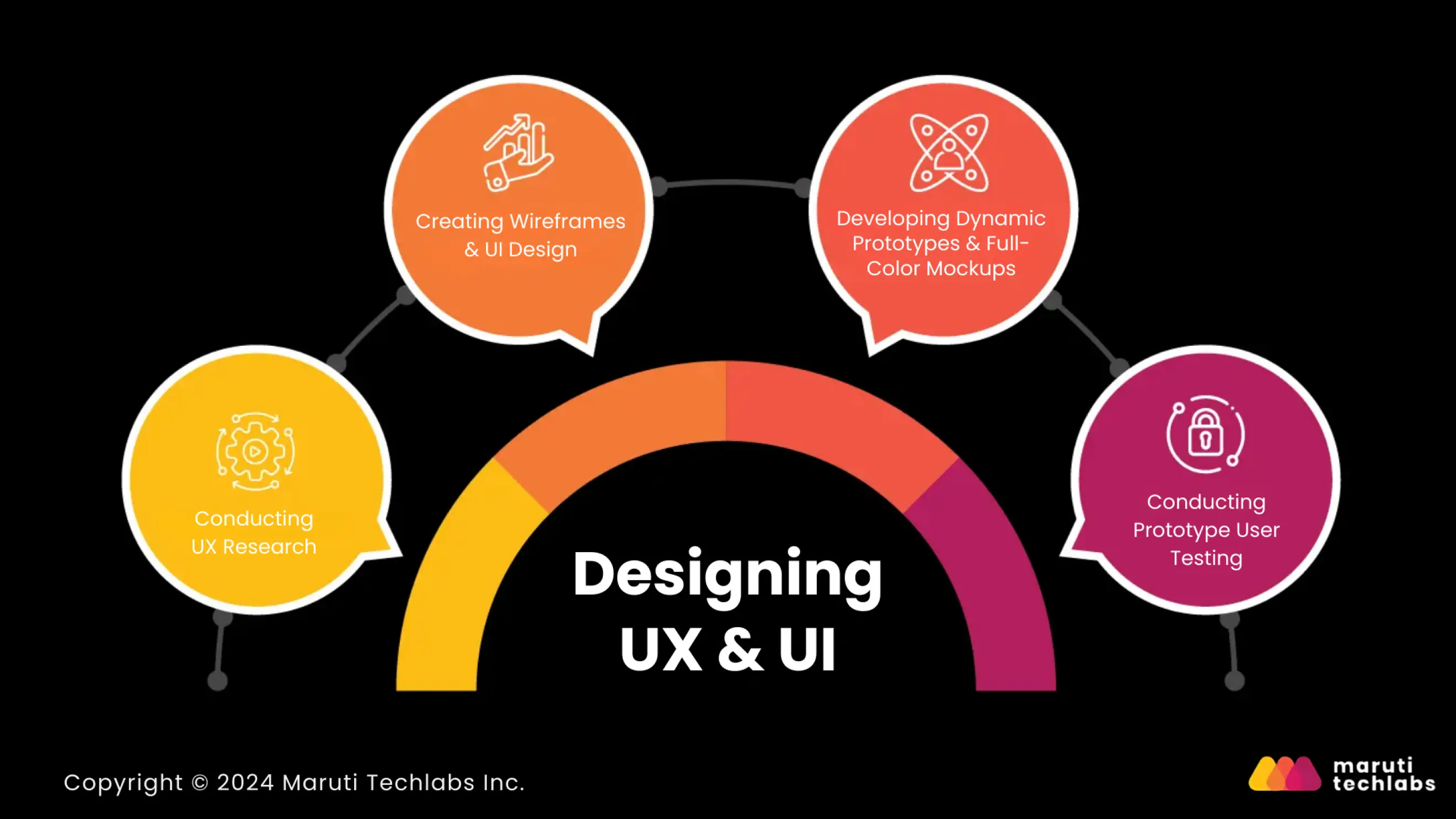
In essence, UX research provides the backbone of any process that comes to be labeled user-centered design. It is essentially a need and understanding of how users behave, the pain points they face, and their motivations. This can be through one or all of the above methods: usability testing, interviews, focus groups, surveys, and observation of the end-user.
This information on how users interact with either extant solutions or ongoing challenges would allow designers to make decisions by giving top priority to the highest functionality, ease of use, and overall satisfactoriness. The research will inform every stage of the design process and ensure alignment of the final product with real-world user requirements.
Wireframes are essential tools in visualizing the structure and flow of the software. Such low-fidelity sketches outline layouts concerning layout, content placement, and navigation paths that have an overall design blueprint without being distracting from colors or supplying an overly detailed visual.
Once wireframes are completed, the focus goes into UI design, wherein the interface comes alive with thoughtful aesthetics involving color schemes, typography, iconography, and branding elements. It is aesthetic, user-friendly, and consistent with the functionality of the product.
Prototyping is the next step in turning static designs into interactive experiences. Dynamic prototypes simulate fundamental user interactions, allowing the team to experience the flow of the software firsthand. These prototypes can range from basic click-through models to fully functional simulations, depending on the project's complexity.
On the other hand, full-color mockups present a more polished version of the UI, showing stakeholders how the final product will look. Prototypes and mockups help bridge the gap between concept and development, providing invaluable opportunities to test assumptions before committing to code.
A prototype needs to be tested on real users for spotting design flaws and usability problems at an early stage. It has been found that designers can find all the pain points, navigation difficulties, or confusing elements when they watch real users interacting with the prototype.
A cycle of testing followed by refinement ensures that the final software's UX and UI are optimized for effectiveness and ease of use. The prototype stage delivers continuous feedback loops that ensure a product with user expectations fulfilled or even surpassed, leading to higher user satisfaction and engagement.
After laying the foundation with a clear understanding of requirements and a well-structured plan, the next critical phase is architecting the software. This involves designing the core infrastructure supporting the software’s functionality, scalability, and security.
A robust architecture is essential for the software's performance and security.
Breaking the software into smaller, functional modules simplifies the development and testing processes. Each module is crafted to perform a specific function, with distinct responsibilities and clearly defined boundaries. This modular approach promotes flexibility, enabling developers to work on separate features independently without affecting the overall system.
It also supports reusability, as modules can be repurposed for future projects or expanded with new functionalities. Moreover, a clearly defined interface between modules ensures seamless communication and integration, fostering more accessible updates and scaling.
Security and scalability must be woven into the architecture from the very start. A security-first approach ensures the system's protection by ensuring that all coding, data encryption, and authentication are sound. These protections left in the software will keep it resilient to threats from the outside world. Still, scalability is just as important, particularly in applications that will soon handle increasing user loads.
The architecture scales well. In other words, adding more servers or resources at any given time isn't going to degrade performance, so it's the architecture that lets the software grow without compromising performance. This ensures smooth performance even if demand may surge, making this kind of architecture future-proof.
The choice of technology stack—such as front-end, back-end, and database technologies—should align with the project’s functional requirements, performance goals, and team expertise. When choosing the stack, consider the expected user base, development speed, and available technical skills.
Popular Tech Stacks
Ensure the technology stack is scalable and can support future enhancements. Opt for widely adopted, actively maintained technologies to reduce the risk of obsolescence.
With cloud services, deployment and maintenance are smoother and have many advantages. Thus, transferring the infrastructure to the cloud allows teams to scale differently. In fact, teams will only pay for the resources they use, yet ramping up capacities at peak times can be executed promptly.
Cloud platforms also simplify operations by providing built-in security, data management, and backups. Most cloud services also support CI/CD pipelines, so you can have automated deployments and continuous updates, further improving the potential productivity and uptimes of your systems.
Having defined the architecture, software development then shifts into the coding phase, where abstract plans and designs start taking tangible forms as developers begin writing core functionalities that will eventually bring the software to life.
Once the architectural groundwork is laid, the coding phase brings the project to life. This is where the ideas and plans take shape in the form of functional software. To ensure smooth execution, proper environment setup, code quality, and documentation are critical.
The first step is establishing distinct development, testing, and automation environments. A well-configured environment for software means that the team can code efficiently, and the testing and automation environments catch bugs or performance issues early. Changes to code are accounted for and managed collaboratively by using version control systems like Git, which minimizes errors and conflicts.
The CI/CD pipelines make sure that testing and deployment are automated so the iterations and code delivery can be faster yet more reliable. Automation frameworks not only speed up testing but also ensure consistency, which leads to better-quality code.
The core of the solution, however, is server-side code, which includes heavy functions such as business logic handling, data processing, and user authentication. Regarding the application point of view, APIs link the server-side code to other software components to facilitate communication and exchange of data in a smooth way.
Therefore, it is very important that such designing of APIs becomes strong, well-logged APIs so that systems are scalable and interoperable.
The development process of a fully functional GUI, or Graphical User Interface, ensures an intuitive and seamless experience for the end user when using the software. This maintains a continuous balance in the scope between both directions of the development process: the back end and the front end.
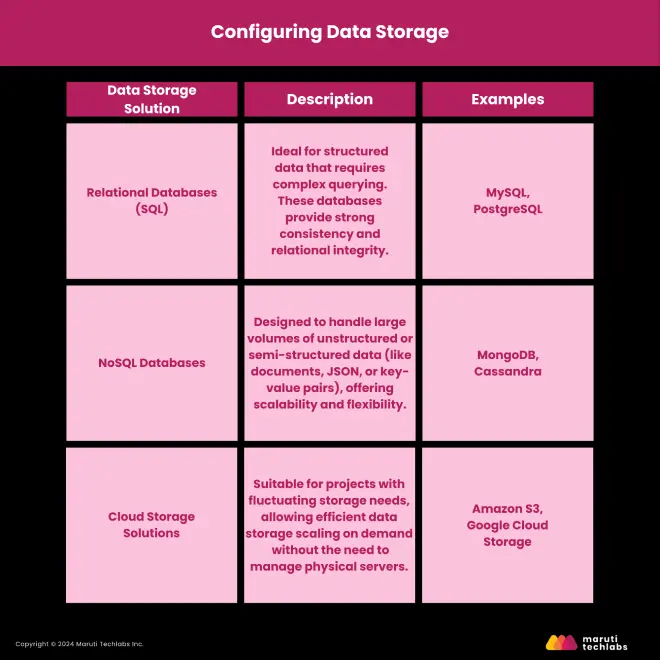
Data storage is essential in every software system, and it involves performance and scalability. Depending upon project requirements, there are various storage solutions.
Data Storage Solution | Description | Examples |
|---|---|---|
Relational Databases (SQL) | Ideal for structured data that requires complex querying. These databases provide strong consistency and relational integrity. | MySQL, PostgreSQL |
NoSQL Databases | Designed to handle large volumes of unstructured or semi-structured data (like documents, JSON, or key-value pairs), offering scalability and flexibility. | MongoDB, Cassandra |
Cloud Storage Solutions | Suitable for projects with fluctuating storage needs, allowing efficient data storage scaling on demand without the need to manage physical servers. | Amazon S3, Google Cloud Storage |
In projects incorporating artificial intelligence, the development and fine-tuning of AI models are essential to delivering advanced functionalities. This process begins by selecting the right algorithm for the task—machine learning, natural language processing, or predictive analytics. Training the AI model on high-quality, relevant datasets is crucial for accuracy and reliability.
Throughout the development of software, models are continuously tuned and optimized based on evaluation metrics, ensuring they perform effectively in real-world scenarios. Regular validation of the AI models using new data helps avoid overfitting and ensures the system remains adaptable to evolving user needs.
Proper documentation is a silent collaborator for successful software projects. Writing code naturally tends to document important processes, architectures, and decisions that are being made.
Proper documentation makes it easier for developers to understand the codebase, supports a smooth handover, and saves time when new members join the team. It includes a roadmap for debugging, troubleshooting, or further improvements. Well-kept documentation is a guide by which future changes or upgrades in the system could be made without potentially interfering with core functionalities.
In some cases, the integration of the whole system is necessary to fully harness the benefits of software. These integrations allow for greater functionality and more data exchange, leading to an enhanced user experience.
Integrating the software with existing systems is often necessary for enhancing functionality and user experience.
Establishing secure integrations is paramount for protecting sensitive data while ensuring that information flows smoothly between the software and other systems. This involves the following integrations:
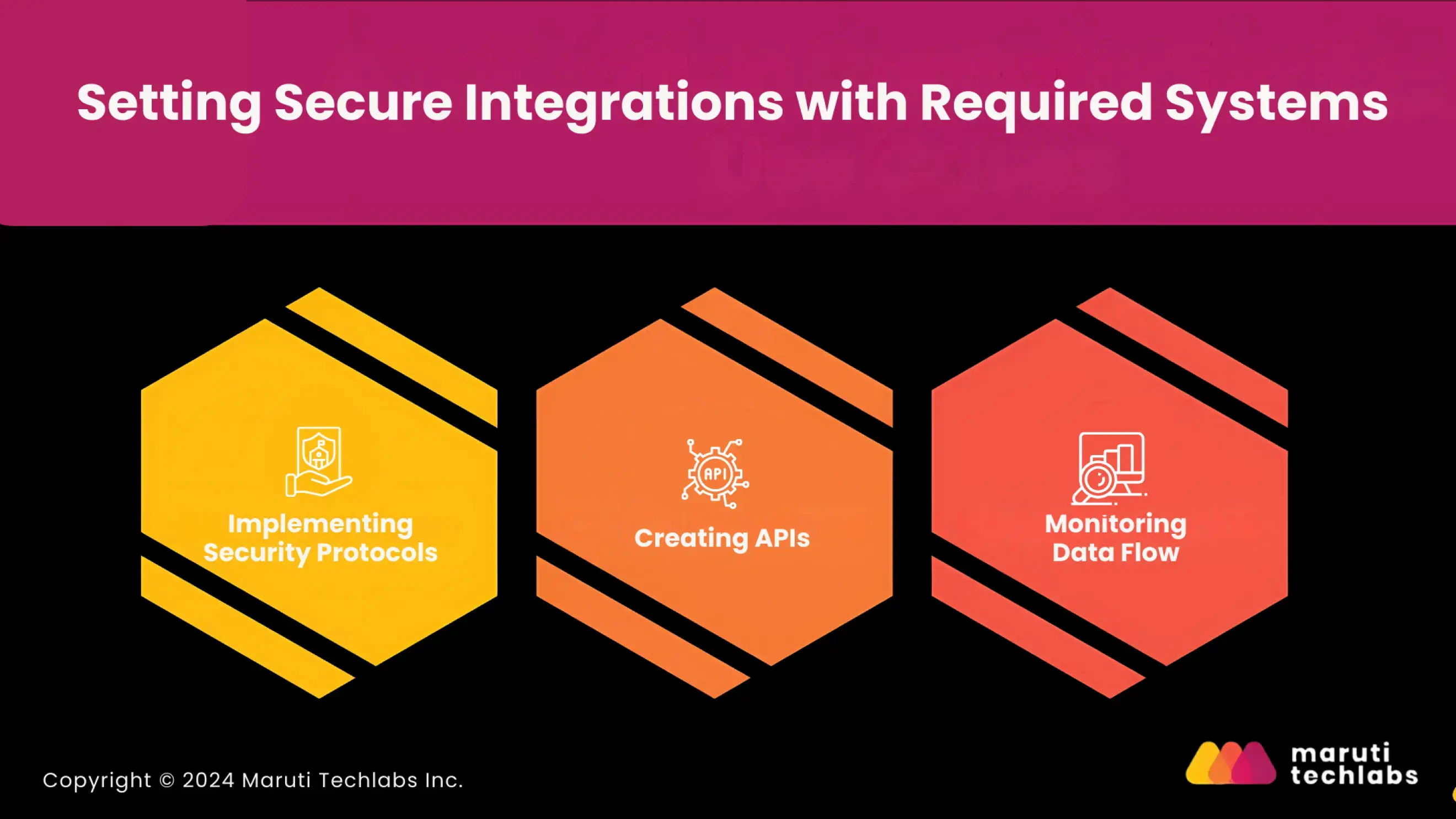
Implementing Security Protocols: Employing robust security measures such as OAuth, SSL/TLS, and data encryption safeguards sensitive information from unauthorized access and breaches. Regular security assessments and audits are vital to identify vulnerabilities in the integration points.
Creating APIs: Well-designed Application Programming Interfaces (APIs) form the bedrock of secure integrations; each system can be well-questioned and be able to go along with communication processes. In this case, the APIs should be documented in detail to ensure ease of use as well as ensuring that the standards regarding security are adhered to.
Monitoring Data Flow: Continuous monitoring of data exchange between systems helps determine anomalies or unauthorized access attempts so interventions toward maintaining security integrity can be performed on time.
Integrating various external sources and services can significantly enhance the capabilities of the software. This approach provides numerous benefits:
Facilitating the integration of well-established applications are corporate applications such as ERP, CRM, or HR systems, which can be used to simplify the flow of information further and help facilitate resourceful production in operations. This normally reduces the number of manual data entry processes and decreases the chances of human error; hence, for a business, it gives an elaborate view of the overall operation.
Accessing external data sources, such as market analytics, social media feeds, or geolocation services, enriches the software's functionality. This integration enables businesses to leverage real-time data, facilitating informed decision-making and personalized user experiences.
Incorporating third-party services, such as payment gateways, communication tools, and analytics platforms, can significantly enhance the software's value proposition. These integrations not only add functionality but also improve user satisfaction by providing a seamless and intuitive experience.
Once the software is fully coded, rigorous testing is essential to ensure it performs correctly, meets requirements, and is free from defects before being released to users.

Thorough testing ensures the software functions correctly and meets user needs.
A good test plan provides a base for the entire testing process, which would include the overall strategy scope of testing by stating what types of tests are to be done, the resources needed, and approximately how long it is expected to take. The primary document clearly states the testing objectives, methodologies, and success criteria.
This would then mean that test cases produced out of the SRS document will be of good coverage for functionalities under test and will help the testing team verify that every feature meets the specified requirements systematically. Documentation of these test cases, therefore, would ensure no critical aspect of the software is left out.
The automation process, to a great extent, contributes to making testing quite fast and consistent. Automated testing frameworks assist development teams in creating scripts that can be run automatically, minimizing several human efforts toward repetitive testing.
Regression testing is particularly valuable with this feature because ensuring that introduced changes do not affect an existing functionality is quite vital.
Additionally, unit tests test every tiny little piece of software and make sure that every single one works before they are integrated into the extensive system. This is one of the early defect detection mechanisms that can help streamline the development of a software process while reducing the possibilities of defects.
The testing process involves multiple types of testing to ensure the software is both robust and reliable. Functional testing ensures the software meets its specified requirements, verifying that all features function as expected.
Performance testing assesses the software's behavior under different conditions, focusing on load handling, response times, and scalability. This is crucial to confirm that the software can manage the anticipated user load without a decline in performance.
Security testing also protects the various possible vulnerabilities pertaining to data security within the software so that sensitive data is well covered. Strong evaluation of these features will help teams ensure that they hand over a secure, high-performance product.
Identifying and fixing bugs during testing is critical to delivering a quality product that meets user expectations. A systematic approach to bug tracking and resolution ensures that issues are addressed promptly and efficiently. By using bug-tracking tools, development teams can categorize, prioritize, and monitor the resolution of issues.
This organized method helps maintain accountability and facilitates communication among team members, ensuring that all stakeholders are informed of the software's status. By addressing bugs early in the development of a software cycle, teams can enhance the overall quality of the software and reduce the likelihood of costly fixes after deployment.
After passing the rigorous testing phases, the software is ready to be deployed into production. This is a critical step in transitioning the project from development to real-world use.
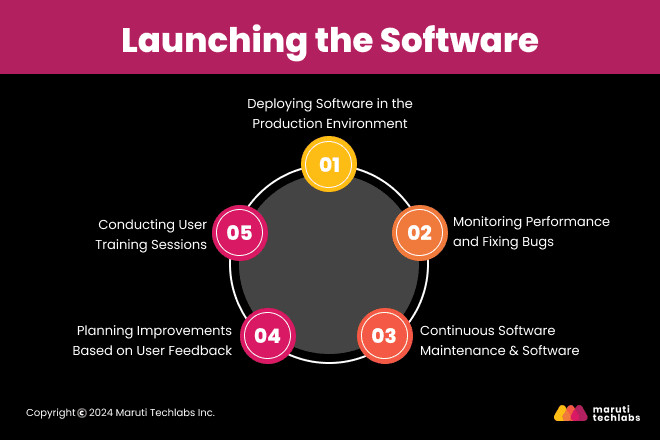
After thorough testing and refinement, the software is launched, transitioning it from the development phase to a live production environment.
Deployment is the process of taking the software out from a controlled developmental environment to the production environment so that it becomes available to the end-users. This stage should be well planned so as to cause minimum time loss and implement a hassle-free changeover.
Concepts such as phased rollouts help in dealing with risks, and in this way, adjustments can be made the moment the users seem to like or dislike the release.
This also allows for automation using deployment tools, which can eliminate many chances of error through human parts while ensuring that the software works exactly like it should in production.
Effective user training is essential for enhancing software adoption and satisfaction. By providing comprehensive training sessions, tutorials, and user manuals, organizations can allow users to leverage the software’s features fully. Tailored training programs that address the specific needs and skill levels of different user groups will foster confidence and proficiency.
Monitoring post-launch is critical to the identification of performance problems and bugs that could begin appearing in the live environment. Continuous monitoring of key performance indicators, user engagement metrics, and system health provides teams with insights into which parts of the application are being used most and where potential system issues may arise.
This approach forces development teams to act every time a bug appears; they must instantly respond to users' complaints for the software to remain useful and dependable. The development of a good incident response plan may allow developers to solve unforeseen issues as quickly as they appear.
User feedback is a treasure trove of insights that can drive ongoing software improvement. Regularly collecting and analyzing this feedback—through surveys, interviews, and usage analytics—guides future updates and enhancements.
Prioritizing user-requested features and addressing pain points can ensure the software evolves in line with user expectations and remains relevant in a fast-paced digital landscape. Engaging with users throughout this process fosters a sense of community and can improve overall satisfaction and loyalty.
Ongoing maintenance and support are crucial for the software's longevity and effectiveness. Regular updates, bug fixes, and feature enhancements keep the software running smoothly and ensure it adapts to changing user needs and technological advancements. Establishing a dedicated support team to address user inquiries and technical issues can enhance user satisfaction and maintain a positive user experience.
By committing to continuous improvement and responsive support, organizations can maximize the value of their software investment over time.
Navigating the development of a software life cycle can be complex, but following a structured approach ensures success. By thoroughly understanding requirements, planning effectively, designing with the user in mind, and executing rigorous testing and deployment strategies, teams can deliver high-quality software that meets business objectives and user needs.
For businesses looking to enhance their software development processes, Maruti Techlabs offers expert solutions tailored to your unique requirements. As a trusted partner for software development New York, we bring deep expertise to every project. Reach out today to discuss how we can help transform your ideas into reality!
Explore our Software Product Development Services to learn more about how we can support your journey.
Selecting the right algorithm is crucial as it directly impacts the model's performance and accuracy. Different algorithms are suited for various tasks, such as classification, regression, or clustering, and choosing the appropriate one ensures that the AI model effectively addresses the specific problem at hand.
Software should be updated regularly based on user feedback, bug reports, and technological advancements. Establishing a maintenance schedule can help ensure the software remains secure, efficient, and relevant to users’ needs. Regular updates can include security patches, new features, and performance improvements.
Best practices include tailoring training content to the specific needs of different user groups, using a mix of instructional methods (e.g., hands-on workshops, video tutorials, user manuals), and providing ongoing support. Encouraging user engagement and collecting feedback during training can also enhance the effectiveness of the sessions.
Continuous monitoring post-launch helps identify performance issues, bugs, and user engagement metrics. This information is vital for making informed decisions about necessary improvements, ensuring the software meets user expectations, and maintaining a positive user experience.
User feedback is invaluable for identifying pain points, enhancing existing features, and guiding future updates. By actively collecting and analyzing feedback, development teams can prioritize user-requested features, ensuring the software evolves in line with user needs and remains competitive in the market.


